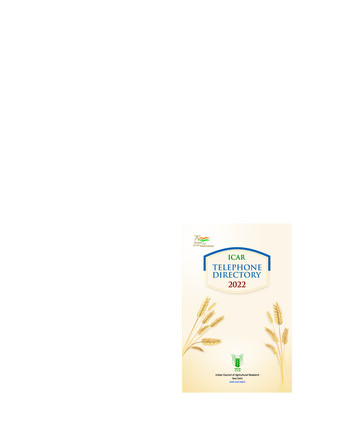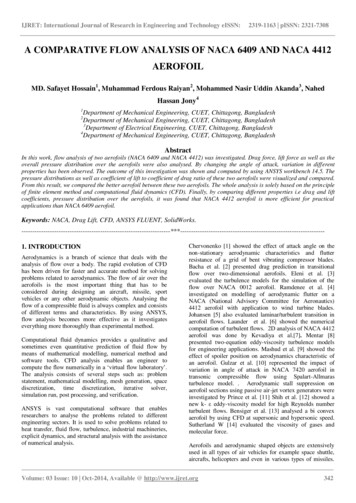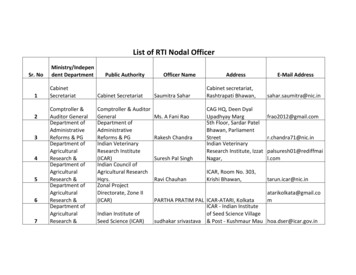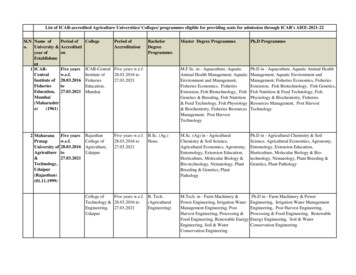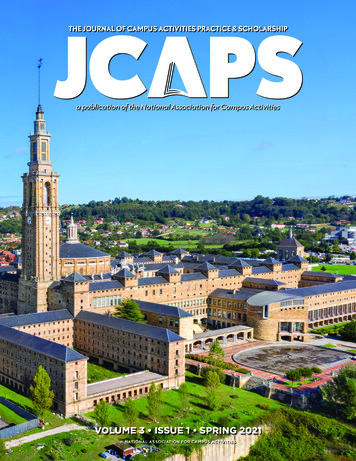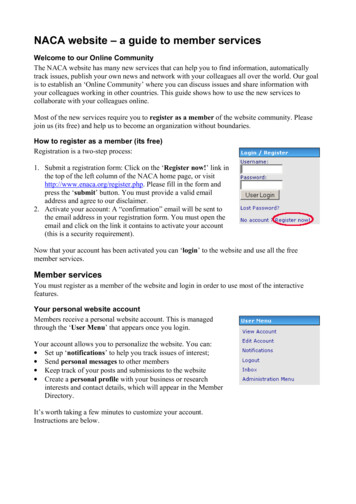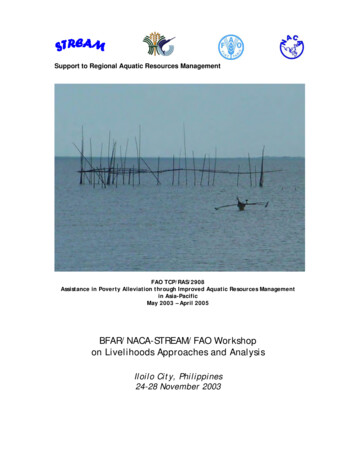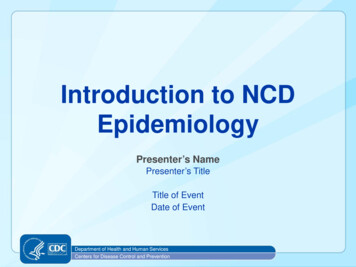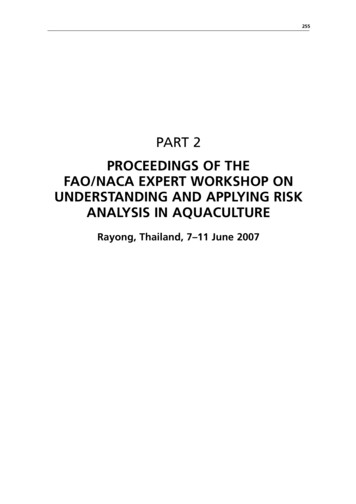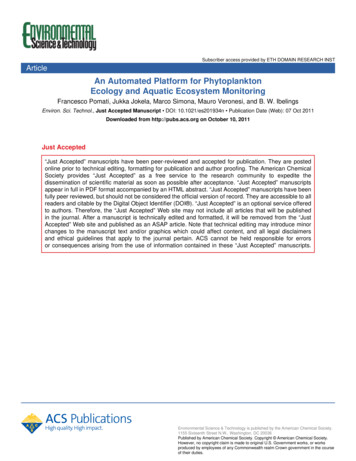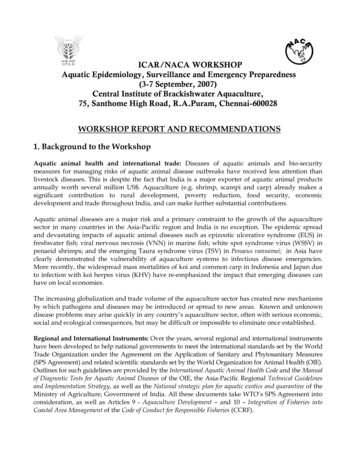
Transcription
ICAR/NACA WORKSHOPAquatic Epidemiology, Surveillance and Emergency Preparedness(3-7 September, 2007)Central Institute of Brackishwater Aquaculture,75, Santhome High Road, R.A.Puram, Chennai-600028WORKSHOP REPORT AND RECOMMENDATIONS1. Background to the WorkshopAquatic animal health and international trade: Diseases of aquatic animals and bio-securitymeasures for managing risks of aquatic animal disease outbreaks have received less attention thanlivestock diseases. This is despite the fact that India is a major exporter of aquatic animal productsannually worth several million US . Aquaculture (e.g. shrimp, scampi and carp) already makes asignificant contribution to rural development, poverty reduction, food security, economicdevelopment and trade throughout India, and can make further substantial contributions.Aquatic animal diseases are a major risk and a primary constraint to the growth of the aquaculturesector in many countries in the Asia-Pacific region and India is no exception. The epidemic spreadand devastating impacts of aquatic animal diseases such as epizootic ulcerative syndrome (EUS) infreshwater fish; viral nervous necrosis (VNN) in marine fish; white spot syndrome virus (WSSV) inpenaeid shrimps; and the emerging Taura syndrome virus (TSV) in Penaeus vannamei; in Asia haveclearly demonstrated the vulnerability of aquaculture systems to infectious disease emergencies.More recently, the widespread mass mortalities of koi and common carp in Indonesia and Japan dueto infection with koi herpes virus (KHV) have re-emphasized the impact that emerging diseases canhave on local economies.The increasing globalization and trade volume of the aquaculture sector has created new mechanismsby which pathogens and diseases may be introduced or spread to new areas. Known and unknowndisease problems may arise quickly in any country’s aquaculture sector, often with serious economic,social and ecological consequences, but may be difficult or impossible to eliminate once established.Regional and International Instruments: Over the years, several regional and international instrumentshave been developed to help national governments to meet the international standards set by the WorldTrade Organization under the Agreement on the Application of Sanitary and Phytosanitary Measures(SPS Agreement) and related scientific standards set by the World Organization for Animal Health (OIE).Outlines for such guidelines are provided by the International Aquatic Animal Health Code and the Manualof Diagnostic Tests for Aquatic Animal Diseases of the OIE, the Asia-Pacific Regional Technical Guidelinesand Implementation Strategy, as well as the National strategic plan for aquatic exotics and quarantine of theMinistry of Agriculture, Government of India. All these documents take WTO’s SPS Agreement intoconsideration, as well as Articles 9 - Aquaculture Development – and 10 – Integration of Fisheries intoCoastal Area Management of the Code of Conduct for Responsible Fisheries (CCRF).
Although a number international regulatory frameworks have been developed, their translation toand implementation at the regional and national levels have been slow to develop, or may be entirelylacking, for a number of reasons. The NACA recognizes that implementation ofinternational/regional/national guidelines and instruments will go a long way in not only helpingcountries to meet the international standards but also to significantly minimize the impact and spread ofserious aquatic animal diseases.Role of NACA: NACA is an intergovernmental organization, owned by its member governments, ofwhich there are currently 17, including India. The objective of NACA is the expansion of sustainableaquaculture and small-scale aquatic resources management, through the promotion of science-basedbest practices in policy, sector management and farm management. NACA operates under theprinciple of Technical Cooperation among Developing Countries (TCDC). The regional program isformulated by the governments, through its Governing Council; with the advice of a TechnicalAdvisory Committee; and a wide range of government, industry and non-government stakeholders,and implemented by the Secretariat. NACA programs and projects are developed through broadparticipation among stakeholders, and are (i) implemented in a participatory manner, ii) aim tostrengthen national capacities while utilizing existing regional and national institutions, (iii) designedto build on rather than duplicate results, and (iv) are shared widely. Aquatic animal healthmanagement is one of NACA’s core programmes, through which support is provided forcooperation, capacity building and improved communications among countries in addressing aquaticdisease problems. The purpose of NACA’s regional Aquatic Animal Health Program in the 21participating countries is to “Reduce risks of aquatic animal disease impacting on livelihoods ofaquaculture farmers, national economies, trade and human health”. The regional health program ofNACA provides technical assistance to countries to implement practical national aquatic animalhealth strategies.Role of ICAR: ICAR through its eight fishery institutes is carrying out research on all aspects offisheries and have trained manpower and facilities on aquatic health. Central Institute of BrackishwaterAquaculture (CIBA) and Central Institute of Freshwater Aquaculture (CIFA) have active researchprograms on existing and emerging aquaculture diseases. National Bureau of Fish Genetics andResources (NBFGR) is the nodal research organization entrusted with task of providing researchsupport on quarantine. These three institutes along with fishery colleges under AgricultureUniversities are working on various aspects of aquaculture disease management.National Strategic Plan: In the year 1999, the Department of Animal Husbandry and Dairying, underthe Ministry of Agriculture, Government of India entrusted the task of developing national strategicplan and guidelines for dealing with aquatic exotics and quarantine to NBFGR. NBFGR undertook aseries of activities (workshops, consultative processes, brainstorming sessions) between 2000 and 2002involving the relevant stakeholders at the national level and developed two national documents: (1)National strategic plan for aquatic exotics and quarantine and (2) Aquatic exotics and quarantineguidelines. The strategic plan and guidelines have been approved by the Ministry of Agriculture, forimplementation in the country. The strategic plan and guidelines cover most of the important elementscontained in the “Asia Regional Technical Guidelines (TG) 1 for responsible movement of live aquaticanimals”. The main elements of the Technical Guidelines incorporated in the national strategic plan areas follows:1Asia Regional Technical Guidelines on Health Management for the Responsible Movement of Live Aquatic Animals and the Beijing consensus andImplementation strategy, 2000. FAO/NACA. Fisheries Technical Paper No 402
1. Pathogens to be considered2. Disease diagnosis3. Health certification and quarantine measures4. Disease zoning5. Disease surveillance and reporting6. Contingency planning7. Import risk analysis8. National strategies and policy frameworksThe national strategic plan is very broad and provides the basic framework and principles on whichto implement a comprehensive health management strategy. The strategic plan covers most of theissues that needs to be implemented at the state level. The national strategic plan has identified theroles and responsibilities of different stakeholders at the state and national levels. To accomplish thevision envisaged in the national strategic plan, it is very essential, that efforts are made to initiate theimplementation process with the available resources.ICAR and NACA have developed the workshop as a collaborative activity to build capacity andawareness in relevant stakeholders and institutions in order to start the process of implementation ofsome of the key elements identified in the national strategic plan. The 5 day training workshop was heldin CIBA, Chennai from 3-7, September 2007.2. Purpose of the WorkshopThe purpose of the 5 day training workshop was to build capacity and awareness of relevant stakeholders in theareas of aquatic epidemiology, risk analysis, surveillance and emergency preparedness. The long term objectivewas to support implementation of National strategies for better aquatic animal health management with afocus on improved surveillance, reporting, early response, emergency preparedness, risk analysis, certificationand quarantine3. Opening CeremonyThe ICAR/NACA training workshop on “Aquatic epidemiology, surveillance and emergencypreparedness” was held from 3-7th September 2007 in CIBA, Chennai. The training workshop wasopened with a formal inauguration ceremony attended by Prof Ramachandran, Vice Chancellor ofTamil Nadu Agricultural University, Dr Dehadrai, former DDG of ICAR and Dr Sakthivel, formerDirector of MPEDA. Dr Ponniah welcomed the guests, resource experts from outside India, andparticipants. CV Mohan briefed the participants and dignitaries about the workshop. The chief Guestformally inaugurated the training workshop by lighting the traditional lamp and delivered theinaugural address and highlighted the importance of aquatic animal health management and need forestablishing national aquatic animal health strategies. Dr Dehadrai and Dr Sakthivel also spoke on theoccasion and urged the participants to make use of the opportunity and take up follow up activities.Dr Santiago proposed the vote of thanks
4. ParticipationThe training workshop was attended by 34 middle and senior level officers from over 18 key nationalinstitutions in India (e.g. ICAR institutions, state agricultural universities, state fisheries departments,MPEDA, private sector). The list of participants is provided as Annex 1. Resource experts fromAustralia (Dr Angus Cameron), Thailand (Dr Supranee Chinabut), Philippines (Dr Celia Pitogo),Indonesia (Dr Agus Priyono), Vietnam (Dr Tiep), India (Dr Indrani Karunasagar, Dr Ponniah, DrSantiago,Dr Sarada, Dr Ravishankar, Dr Rehana Abidi and Dr. Kalaimani) and NACA (Dr CVMohan) provided expert inputs to the workshop.5. ProcessThe training workshop had three components that were integrated in a logical fashion to ensurecontinuity and enhance uptake. The Training component included lectures on concepts ofepidemiology, application of epidemiology (e.g. disease investigations, conduct of surveys, samplingissues), surveillance, qualitative risk analysis and contingency planning. The second componentfocused on sharing of experiences from other countries (e.g. Australia, Thailand, Philippines,Indonesia, Vietnam) that are implementing national aquatic animal health strategies in the AsiaPacific region. This included areas such as national plans, working of national advisory committee,national list of diseases, national surveillance and reporting framework, national contingency plans,national aquatic animal health networks, etc. The third component consisted of facilitated interactionsessions. These sessions were used to discuss and agree on simple and practical approaches toimplement national aquatic animal health strategies in India with the available resources andexpertise. The time table followed is provided as Annex 2All workshop participants were provided with CDs containing all the presentations made at theworkshop, plus copy of survey tool box text book, software for epidemiological analysis and otherresource documents.The Australian Government Department of Agriculture, Fisheries and Forestry provided CDs ofAuqavetplan and copies of Aquaplan 2005-2010 for distribution to all the participants. Organizers andparticipants recognized the value of the resource material provided and acknowledged the inputsprovided by DAFF.6. OutputThe workshop contributed to the following key outputs: Increased capacity in aquatic epidemiology, risk analysis, surveillance, and emergencypreparedness amongst relevant national stakeholders and institutions Increased awareness amongst relevant stakeholders on global treaties and instrumentsrelated to aquatic health issues that govern trade in live aquatic animals and aquacultureproducts Establishment of a informal network of individuals and institutions to supportimplementation of national strategies on aquatic animal health management in India
7. Working Group OutputsThe working groups were asked to prioritize elements for implementation of national aquatic animalhealth strategies and develop some action plans. The findings of the working groups were presentedat the plenary session and used for developing the workshop recommendations.Outputs from Working Group 1:1. Establishment of surveillance network for aquatic animal diseases Identified the sources of information and developed a pathway flow chart for surveillance,flow of information and reporting Documentation -National Database National check list of endemic diseases/pathogens List of pathogens of national concern3. Quarantine facility and health certification Separate Quarantine Directorate 3 ports of entry Uniform Quarantine Policy for all aquatic organisms/products import/export Certification by OIE certified Authority4. Capacity Building Diagnostic facility at District level Human Resource Development Training to field level technicians Preparation of field guides/manuals5. Import Risk Koi Carp (KHV) Seabass (Noda Virus) Grouper (Irido Virus) Pacific White Shrimp (IMNV, TSV) Pangasius suchiWorking Group 2:Key elements1Database on diseases2Reporting of diseasesApproaches Compilation of existing information availablein different research organizations,universities, health laboratories, stategovernments, peer reviewed journals andgrey literatures Networking of laboratories, identification ofmechanism/personnel and systematic flow ofinformation to a designated body for furthercompilation and necessary actionNetworking of aquaclubs/aquaclinics;formation of new aquaclinicsRegistration of farmers/farms/hatcherieswith state fisheries departments
3Preparation of national listof diseases of concern4Strengthening diagnosticsystem 5Import risk analysis 6Contingency planning 7Health certification 8Quarantine 9Legislation 10Immediate next action Through conducting workshop to identifynational priorityRecognition of national laboratories forspecific pathogens of concernAccreditation of laboratoriesStrengthening of existing diagnosticlaboratories and the facilities and capacitybuilding at regional levelIRA for potential species/products likely toimportedContingency planning for diseases KHV,TSV, IMNV, Monodon slow growthsyndromeMechanism for compensation to the farmersin case of destruction of productsRecognition of personnel/experts by thegovernment authority (DAHDF) for healthcertificationLinking of groups involved in healthcertificationSOP for health certificationHRD for quarantineEstablishment of quarantine facilities at focalpoints for internal and external movements offish and fish productsAccreditation of private quarantine facilitiesAmendment of existing livestock importationact for effective implementation of fishquarantineListing and networking of all those who areinvolved in aquatic animal healthA high level meeting including policy makersconcerned with AAH
8. Workshop RecommendationsThe recommendations are based on the outcomes of the two working groups.Considering the existence of national strategy for aquatic animal exotics and quarantine and as afollow up to the ICAR-NACA workshop on Aquatic epidemiology, surveillance and emergencypreparedness (3-7 September, CIBA, Chennai) the following draft recommendations have beenproposed:– Develop one national network program to progress the implementation of nationalsurveillance (NBFGR to lead the national initiative)– Develop one national network program to progress the implementation ofepidemiological studies for key national diseases of concern (CIBA and CIFA to leadthe national initiatives for BW and FW fishes respectively)– Initiate actions to develop a national disease database based on surveillance (NBFGR)- Develop and finalize list of diseases of national concern for the purpose of surveillanceand reporting and for undertaking further epidemiological studies on diseases ofnational concern. This list could be under three categories (i)Diseases not reported fromIndia (ii)Disease reported from India but from select geographic areas and (iii)Diseases widely present in the country but control measures are deemed necessary-----–––(CIBA,CIFA,CMFRI &NBFGR to carry out as a post workshop initiative)Strengthening diagnostic system with recognition of national laboratories for specificpathogens of concern, accreditation of laboratories and strengthening of existingdiagnostic laboratories and the facilities and capacity building at regional level bycreating diagnostic facility at district level, human resource development by way oftraining field level technicians and preparation of field guides and manuals.Develop and implement training workshop on IRA in collaboration with NACA (CIBAto lead the national initiative).Conduct IRA for (the exotic species which are already present in the country (like KoiCarp, Pacific White Shrimp and Pangasius suchi ) or likely to be imported in the nearfuture.Develop contingency planning for diseases KHV, TSV, IMNV & Monodon slowgrowth syndrome and possible compensation to the farmers in case of destruction ofproductsDevelop health certification programme with recognition of personnel/experts by thegovernment authority (DAHDF) for health certification ; linking of groups involved inhealth certification, and SOP for health certificationDevelop quarantine procedures by formation of a separate directorate for quarantineas in Indonesia, HRD for quarantine, and establishment of quarantine facilities at threeports of entry for internal and external movements of fish and fish products andaccreditation of private quarantine facilities and amendment of existing livestockimportation act for effective implementation of fish quarantine.Develop and implement training workshop on surveillance and reporting incollaboration with NACADevelop a policy document of Indian aquatic animal health with the involvement of allstakeholders which will guide the research development activities in this field andintegrate it with overall aquaculture planning.Develop specific TOR for the national exotics committee to deal with aquatic animaldiseases OR consider establishing a national technical working group for dealing withaquatic animal diseases and implementing national aquatic animal health strategies
-The following guidelines may be issued to editors/publishers of books/journals whilepublishing articles that contain information on exotic diseases and exotic pathogens.The Ministry of Agriculture to be appraise about the potential dangers of publishingwork on exotic diseases and exotic pathogens without a proper review.o The source of exotic pathogen, clearly intimating the details of the host fromwhich the pathogen was collected, the time and place from where the specimenwas obtained, the quarantine measures taken so that the pathogen is not spreadto other places, should be clearly reflected in the article.o When a exotic disease has been identified in India the same should be confirmedby sending samples through the competent authority to two or three labs dulyrecognized for the purpose for confirmation before communicating to anyjournal for publication of the finding.Note: For some recommendations the institutes were identified by the participants. However thisis subject to modification based on the EOIs and mandates of the institutes. For all therecommendations, the concerned lead agencies could develop a work programme which is timebound with the responsibilities clearly defined with no overlap.9. Closing CeremonyThe Valedictory function of the workshop was held on 7th September afternoon from 4.00-6.00 PM atthe seminar hall of CIBA. NACA welcomed the dignitaries and participants. Prof L Kannan, ViceChancellor of Theruvalluvar University gave the valedictory address. Dr Alfred Selvakumar, formerADG of ICAR gave the presidential address. Both Prof Kannan and Alfred Selvakumar appreciatedthe role played by NACA and the collaboration with ICAR. Dr Ponniah provided the concludingremarks and emphasized the importance of need for networking amongst participating institutions totake up follow up activities identified by the working groups. Three participants provided feed backon the workshop. Participants recognized the present workshop as the first attempt in the country increating awareness in the areas of aquatic epidemiology, surveillance and emergency preparedness.Certificate of participation was distributed to all the participants by Prof Kannan and Dr AlfredSelvakumar. The role played by NACA and CIBA in planning, coordinating and executing theworkshop was appreciated by all the participants. The function ended with a vote of thanks extendedby Dr. N. Kalaimani.
Annex 2ICAR/NACA WORKSHOPAquatic Epidemiology, Surveillance and Emergency Preparedness(3-7 September, 2007)Central Institute of Brackishwater Aquaculture,75, Santhome High Road, R.A.Puram, Chennai-600028Time TableTimeTopicPresenter3/9/2007 stration FormalitiesInaugural SessionTea BreakFormal IntroductionsBackground to the training workshop-Purpose, process,participation and productGlobal aquatic animal health issues and need forcomprehensive national aquatic animal health strategiesBasic concepts in epidemiology and its relevance tonational aquatic animal health strategiesLunch BreakConcept of causation, patterns of disease, measures ofdisease and measures of associationsConcept of disease diagnosis and experiences from PCRcalibration study conducted in IndiaTea BreakTypes of surveys, Outbreak investigation, sampling anddata collectionApplication of molecular tools in disease diagnosis etNACAAusVetCOFM/India4/9/2007 15.30Types of epidemiological studies (e.g. longitudinal, casecontrol)White spot disease risk factor study in India- an exampleTea BreakConcept, purpose and types of surveillanceKHV surveillance in ThailandSurveillance and disease reporting in Asia-PacificLunch BreakAquatic animal disease information management anddisease reportingMolecular epidemiology - Role in vaccines and diseaseAusVetNACAAusVetThailandNACAAusVetTANUVAS
15.30-16.0016.00-17.0017.00-1730diagnosisTea BreakRisk analysis concept, components, methodology, andapplicationsGenerating and monitoring of animal health informationIndian Scenario./IndiaAusVetADMS/India5/9/2007 6.00-16.3016.30-17.0017.00-17.30Application of rapid field diagnostics in surveillance andcontingency planningAquaculture and Aquatic Animal Health-IndianPerspectivesAquaculture and Aquatic Animal Health-ThailandPerspectivesTea BreakAquaculture and Aquatic Animal Health-PhilippinesPerspectivesAquaculture and Aquatic Animal Health-VietnamPerspectivesAn Assessment of the Economic Losses Resulting fromincidences of Various Diseases in Shrimp Farms in India &Predictors for losses in shrimp aquaculture –a case studyIssues in diagnostics of WSSV in shrimp brooders andpost-larvaeLunch BreakAquaplan-Australia’s National aquatic animal healthstrategyDevelopment and Implementation of National Strategieson Aquatic animal health-ThailandBackground to National Strategy development in IndiaTea BreakNational aquatic animal health committee and national listof diseases in AustraliaNational Aquatic Animal Health Committee and nationallist of diseases in ThailandNational Aquatic Animal Health Committee and nationallist of diseases in CIBA/IndiaAustraliaThailandPhilippines6/9/2007 nal aquatic animal health committee and National listof diseases in VietnamNational Aquatic Animal Health Committee and nationallist of diseases in IndonesiaTea BreakSurveillance and reporting in AustraliaSurveillance and disease reporting in ThailandSurveillance and reporting in VietnamSurveillance and disease reporting in PhilippinesLunch ppines
16.3016.30-17.0017.00-17.30Surveillance and disease reporting in IndonesiaConcept of quarantine and health certificationQuarantine and health certification in ThailandTea BreakQuarantine and health certification in VietnamQuarantine and health certification in ndonesia7/9/2007 0014.00-16.0016.00-16.3016.30-17.30Quarantine and health certification in PhilippinesConcept of contingency planning in aquatic animal healthmanagementAquavetplan-Australia’s National contingency planTea BreakEmergency preparedness in ThailandImport risk analysis in PhilippinesImport risk analysis in ThailandGeneral DiscussionsLunchFacilitated discussions on Implementation of aquaticanimal health strategies in India Practical approaches Networking and communication Coordination Monitoring, review and revisionsTea BreakClosing ThailandCIBA
ICAR/NACA WORKSHOP Aquatic Epidemiology, Surveillance and Emergency Preparedness (3-7 September, 2007) Central Institute of Brackishwater Aquaculture, 75, Santhome High Road, R.A.Puram, Chennai-600028 WORKSHOP REPORT AND RECOMMENDATIONS 1. Background to the Workshop
